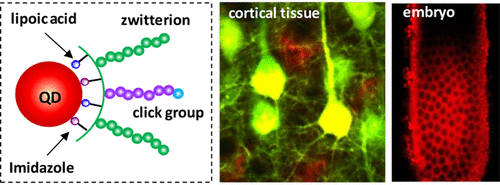当前位置:
X-MOL 学术
›
Bioconjugate Chem.
›
论文详情
Our official English website, www.x-mol.net, welcomes your
feedback! (Note: you will need to create a separate account there.)
Compact, "Clickable" Quantum Dots Photoligated with Multifunctional Zwitterionic Polymers for Immunofluorescence and In Vivo Imaging.
Bioconjugate Chemistry ( IF 4.0 ) Pub Date : 2020-05-11 , DOI: 10.1021/acs.bioconjchem.0c00169 Wentao Wang 1 , Erna A van Niekerk 2 , Yang Zhang 3 , Liang Du 1 , Xin Ji 1 , Sisi Wang 1 , James D Baker 3 , Kimberly Groeniger 2 , Françisco M Raymo 3 , Hedi Mattoussi 1
Bioconjugate Chemistry ( IF 4.0 ) Pub Date : 2020-05-11 , DOI: 10.1021/acs.bioconjchem.0c00169 Wentao Wang 1 , Erna A van Niekerk 2 , Yang Zhang 3 , Liang Du 1 , Xin Ji 1 , Sisi Wang 1 , James D Baker 3 , Kimberly Groeniger 2 , Françisco M Raymo 3 , Hedi Mattoussi 1
Affiliation

|
We detail the preparation of highly fluorescent quantum dots (QDs), surface-engineered with multifunctional polymer ligands that are compact and readily compatible with strain-promoted click conjugation, and the use of these nanocrystals in immunofluorescence and in vivo imaging. The ligand design combines the benefits of mixed coordination (i.e., thiol and imidazole) with zwitterion motifs, yielding sterically-stabilized QDs that present a controllable number of azide groups, for easy conjugation to biomolecules via the selective click chemistry. The polymer coating was characterized using NMR spectroscopy to extract estimates of the diffusion coefficient, hydrodynamic size, and ligand density. The azide-functionalized QDs were conjugated to anti-tropomyosin receptor kinase B antibody (α-TrkB) or to the brain-derived neurotrophic factor (BDNF). These conjugates were highly effective for labeling the tropomyosin receptor kinase B (TrkB) in pyramidal neurons within cortical tissue and for monitoring the BDNF induced activation of TrkB signaling in live neuronal cells. Finally, the polymer-coated QDs were applied for in vivo imaging of Drosophila melanogaster embryos, where the QDs remained highly fluorescent and colloidally stable, with no measurable cytotoxicity. These materials would be of great use in various imaging applications, where a small size, ease of conjugation, and great colloidal stability for in vivo studies are needed.
中文翻译:

与多功能两性离子聚合物光连接的紧凑型“可点击”量子点,用于免疫荧光和体内成像。
我们详细介绍了高度荧光量子点(QDs)的制备,表面工程化的多功能聚合物配体,该聚合物结构紧凑且易于与应变促进的点击缀合兼容,并在免疫荧光和体内成像中使用这些纳米晶体。配体设计结合了混合配位(即硫醇和咪唑)与两性离子基序的优势,产生了空间稳定的QD,这些QD具有可控制的叠氮基团数量,易于通过选择性点击化学与生物分子偶联。使用NMR光谱对聚合物涂层进行表征,以提取扩散系数,流体动力学尺寸和配体密度的估计值。将叠氮化物官能化的QD与抗原肌球蛋白受体激酶B抗体(α-TrkB)或与脑源性神经营养因子(BDNF)偶联。这些缀合物在标记皮质组织内锥体神经元中的原肌球蛋白受体激酶B(TrkB)和监测BDNF诱导的活神经细胞中TrkB信号的激活方面非常有效。最后,将聚合物包被的QD用于果蝇果蝇胚胎的体内成像,其中QD保持高荧光性和胶体稳定性,没有可测量的细胞毒性。这些材料将在各种成像应用中得到广泛应用,在这些成像应用中,需要小尺寸,易于缀合且对于体内研究具有很大的胶体稳定性。聚合物包被的量子点被用于果蝇胚胎的体内成像,其中量子点保持高荧光性和胶体稳定性,没有可测量的细胞毒性。这些材料将在各种成像应用中得到广泛应用,在这些成像应用中,需要小尺寸,易于缀合且对于体内研究具有很大的胶体稳定性。聚合物包被的量子点被用于果蝇胚胎的体内成像,其中量子点保持高荧光和胶体稳定,没有可测量的细胞毒性。这些材料将在各种成像应用中得到广泛使用,在这些成像应用中,需要小尺寸,易于缀合以及对于体内研究具有很大的胶体稳定性。
更新日期:2020-04-25
中文翻译:

与多功能两性离子聚合物光连接的紧凑型“可点击”量子点,用于免疫荧光和体内成像。
我们详细介绍了高度荧光量子点(QDs)的制备,表面工程化的多功能聚合物配体,该聚合物结构紧凑且易于与应变促进的点击缀合兼容,并在免疫荧光和体内成像中使用这些纳米晶体。配体设计结合了混合配位(即硫醇和咪唑)与两性离子基序的优势,产生了空间稳定的QD,这些QD具有可控制的叠氮基团数量,易于通过选择性点击化学与生物分子偶联。使用NMR光谱对聚合物涂层进行表征,以提取扩散系数,流体动力学尺寸和配体密度的估计值。将叠氮化物官能化的QD与抗原肌球蛋白受体激酶B抗体(α-TrkB)或与脑源性神经营养因子(BDNF)偶联。这些缀合物在标记皮质组织内锥体神经元中的原肌球蛋白受体激酶B(TrkB)和监测BDNF诱导的活神经细胞中TrkB信号的激活方面非常有效。最后,将聚合物包被的QD用于果蝇果蝇胚胎的体内成像,其中QD保持高荧光性和胶体稳定性,没有可测量的细胞毒性。这些材料将在各种成像应用中得到广泛应用,在这些成像应用中,需要小尺寸,易于缀合且对于体内研究具有很大的胶体稳定性。聚合物包被的量子点被用于果蝇胚胎的体内成像,其中量子点保持高荧光性和胶体稳定性,没有可测量的细胞毒性。这些材料将在各种成像应用中得到广泛应用,在这些成像应用中,需要小尺寸,易于缀合且对于体内研究具有很大的胶体稳定性。聚合物包被的量子点被用于果蝇胚胎的体内成像,其中量子点保持高荧光和胶体稳定,没有可测量的细胞毒性。这些材料将在各种成像应用中得到广泛使用,在这些成像应用中,需要小尺寸,易于缀合以及对于体内研究具有很大的胶体稳定性。











































 京公网安备 11010802027423号
京公网安备 11010802027423号